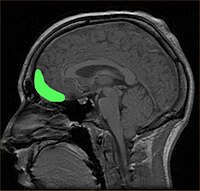
Photo from wikipedia
Risk-taking differs between humans, and is associated with the personality measures of impulsivity and sensation-seeking. To analyse the brain systems involved, self-report risk-taking, resting state functional connectivity, and related behavioral… Click to show full abstract
Risk-taking differs between humans, and is associated with the personality measures of impulsivity and sensation-seeking. To analyse the brain systems involved, self-report risk-taking, resting state functional connectivity, and related behavioral measures were analyzed in 18,740 participants of both sexes from the UK Biobank. Functional connectivities of the medial orbitofrontal cortex, ventromedial prefrontal cortex (VMPFC), and the parahippocampal areas were significantly higher in the risk-taking group (p<0.001, FDR corrected). The risk-taking measure was validated in that it was significantly associated with alcohol drinking amount (r=0.08, p=5.1×10-28), cannabis use (r=0.12, p=6.0×10-66), and anxious feelings (r=-0.12, p=7.6×-98). The functional connectivity findings were cross-validated in two independent datasets. The higher functional connectivity of the medial orbitofrontal cortex and VMPFC included higher connectivity with the anterior cingulate cortex, which provides a route for these reward-related regions to have a greater influence on action in risk-taking individuals. In conclusion, the medial orbitofrontal cortex, which is involved in reward value and pleasure, was found to be related to risk-taking, which is associated with impulsivity. An implication is that risk-taking is driven by specific orbitofrontal cortex reward systems, and is different for different rewards which are represented differently in the brains of different individuals. This is an advance in understanding the bases and mechanisms of risk-taking in humans, given that the orbitofrontal cortex, VMPFC and anterior cingulate cortex are highly developed in humans, and that risk-taking can be reported in humans.
Journal Title: NeuroImage
Year Published: 2022
Link to full text (if available)
Share on Social Media: Sign Up to like & get
recommendations!